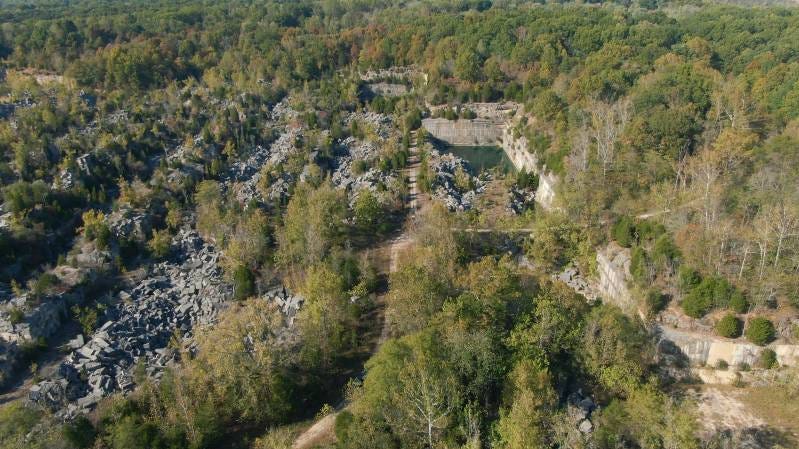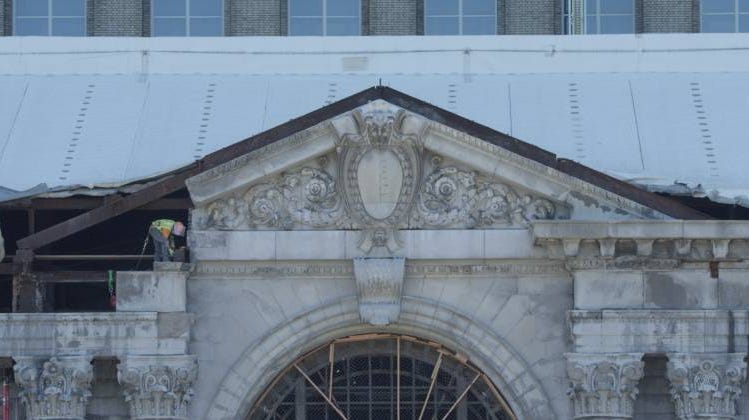
Ford re-opens abandoned Dark Hollow Quarry
As part of the Michigan Central Station restoration, Ford re-opened Dark Hollow Quarry in Indiana, source of the original limestone used for the train station built in 1913.
Provided by Ford Motor Co.
When it comes to limestone formed by glaciers millions of years ago, who knows or who cares about the tiny differences in color or pattern? Well, Bill Ford did.
When it came down to the tiniest detail in restoring Michigan Central Station, Ford didn’t plan to cut corners on the company’s legacy project, even if almost no one would know.
So that meant figuring out the original source of limestone dug up before 1913 and used to build the train station that would service the Motor City when it was called the Paris of the Midwest and later sent soldiers away to World War II and welcomed them home again.

Ford installs limestone at Michigan Central Station
As part of the Michigan Central Station restoration, Ford worked with Capital Stoneworks to install limestone on the interior and exterior of the train station.
That very same limestone was needed to match and replace giant exterior and interior blocks and columns holding up what would become the most ambitious restoration project in Detroit history, opening in Corktown on June 6 after six years of hard labor involving hundreds of millions of dollars. Michigan Central Station closed in 1988, abandoned and destroyed.
First the restoration team had to figure out which part of the Earth produced the unique limestone and then, when that mystery was solved, find the owners of the long-shuttered Dark Hollow Quarry in Indiana and get permission to reopen it. The quarry, untouched for more than three decades, no longer had working roads that would carry trucks down into the quarry pit, and 30-year-old trees had grown up throughout the area.
200 truckloads of stone
“They had thousands of blocks extracted and stacked up prior to closing,” said Brandon Hornung, 49, of Vassar, owner of Capital Stoneworks Inc. “We had more than enough. But the quarry road had to be rebuilt and the trees removed.”
More: Michigan Central Station: How secret basement, flooding nightmare led to renovation delays
A limestone belt runs through Indiana, with different grades and colors, including buff and gray, Hornung told the Detroit Free Press. “A lot of times designers and architects like a clear limestone that doesn’t have a real diagonal grain to it. This was extremely unique. We researched. We went down to that area and started asking around, talking to veterans of the stone industry.
“Then we picked up the blocks from the Dark Hollow Quarry in Indiana using a front-end loader, which can load 40,000- to 50,000-pound loads onto a semi-truck, and move them to our slabbing facility in Bloomington, Indiana. Once we got the slab to be the thickness we needed, we’d ship it to Bridgeport, Michigan, to cut to the required sizes and shapes, and ship it to the job site,” he said.
Truck drivers hauled more than 200 truckloads of stone, which cost the project millions of dollars, Hornung said. He wasn’t surprised by the attention to detail, he said.
“Just the fact of who the owner of Michigan Central was, and his commitment to the heritage of the area,” Hornung said. “You could do anything differently, but it would not be what it is. He could have substituted substandard materials, but it would not have the look or elegance or historical significance it does today.”
Yet finding the limestone wasn’t the biggest challenge.
Bringing an abandoned quarry back to life for the train station
“In my 30 years of historic preservation work, I’ve never had to reopen a quarry before. And we went to the original hole where that Michigan Central Station stone came from,” said Ron Staley, vice president of the Christman Co. and executive director of historic preservation for the Christman/Brinker Corktown joint venture. “They had to actually take chainsaws to cut trees down.”
It wasn’t just that the stone used for the train station on Michigan Avenue had a distinct banding pattern — it is called Dark Hollow rift, a gray limestone with a unique diagonal cross-grain characteristic. It was a product not used much since the middle of the century, Staley said. “It’s usually, when you do projects like this, you try and find stone that’s close, but an exact match is pretty rare.”
To someone like Scott Burdick, assistant professor of environmental science and geology at Wayne State University, it’s absolutely no surprise that a building that sat abandoned through sweltering hot and freezing temperatures and rain and snow since 1988 needed serious repair and replacement of limestone.
“Limestone is made of calcium carbonate, the mineral calcite. It’s the same stuff that’s in Tums,” he said. “If you expose it to the elements, it can weather and dissolve.”
The Indiana limestone belt is known for its vast quarries, with varied coloration and texture. Mineral content changes the color, Burdick said. The brownish buff limestone will have more iron, whereas the silvery blue-gray limestone has more organic material, similar to oil and coal, he said. “If you look closely at limestone, you’ll see it’s mostly tiny pieces of shell material. It formed millions of years ago when the center of the continent was covered with a shallow ocean. The limestone in this area is high quality because it wasn’t getting much sand or mud from land.”
Finding the family that helped back before 1913
Jim Hillenberg, 68, of Bedford, Indiana, worked in the Dark Hollow Quarry back in the 1980s before it closed. He identified the stone and the exact quarry for the Michigan Central Station team. Hillenberg, who worked for Capital Stoneworks Inc., was part of the original team that cut it from the ground and stacked it up decades ago. It’s his markings on the blocks, made with black soot and kerosene and a brush, on the blocks.
His family spent more than 100 years in the quarries of Indiana, and they have ties to Michigan Central, though they’ve never visited.
“My grandfather, Will Hellenberg of Heltonville, was one that originally quarried the first rock for that building,” Hillenberg told the Free Press. “Down here, it’s an everyday job. That’s the way you make your living. Limestone. I’ve done it since I was 18 years old. It’s just like us eating breakfast. I get that there’s people out there that don’t understand this. They need to know. They might wonder, ‘Did they order this off of Amazon and was it here the next day?’ No.”
His grandfather, also a quarryman, died at age 93 when Jim was just 8 years old, he said. “I’d get off the school bus down there and eat supper with them. Grandpa did all the cookin’. He made fried chicken and fried cornbread. Yep. They still cooked on a wood cook stove and had no running water in the house. Wrap your arms around that one. I went to a one-room school my first six years. I’m an old-timer.
Jim Hillenberg, a third-generation quarryman, doesn’t use a computer and doesn’t travel, so he hasn’t seen the finished project, he said.
In the 1900s, limestone was cut by hand using chisels and hammers, using trains to transport blocks to customers where it was carved on site, Ford said in a news release in 2019. Now machines are used. Other buildings that have used Indiana limestone include the Empire State Building in New York, the National Cathedral in Washington, D.C., and the Pentagon.
Once they pulled limestone, finding someone to carve it by hand
Once the team found the limestone, and shipped it to Michigan, someone needed to carve it. Some pieces needed to be reproduced, and the team initially tried to scan pieces into a computer to fabricate building pieces. But there was too much data and the computer kept crashing during a two-week period.
Capital Stoneworks Inc. happened to have a 40-year master stone carver on staff. John Goodrow Sr. of Richville, Michigan, just northeast of Frankenmuth, sat down with the giant limestone blocks.
The biggest part he carved is a 5-foot by 6-foot piece at the top of a building column, called a capital. He also did the leafing carvings over all the doorways inside the train station, and also along the front soffit pieces outside.
“He spent 427 hours carving the first capital,” Hornung said. “It initially weighed 21,000 pounds and John removed almost 9,000 pounds of material to create the ornamental details.”
He used pneumatic air chisels and an air saw. All hand tools.
“It’s a talent. Either you have it or you don’t. I can see it as I’m working on it,” Goodrow, 62, told the Free Press. “I would dream about it. I swear, I would wake up tired of working on it because I worked on it while I slept, day after day.”
He also did medallion and scroll stone carving work at the Michigan State Capitol, as well as areas at Spartan Stadium at Michigan State University as well as stadiums at the University of Michigan and Notre Dame. As the son of a skilled trade machine repairman and homemaker raising seven kids, Goodrow never underwent formal training for his craft or his fine detail work.
“Everybody has something they can do. I knew this was going to be a big task but I wasn’t intimated,” Goodrow said. “The building is going to outlast me and most everybody that’s working here now. It’s basically our legacy.”
Editor’s Note: The reporter’s husband worked on the train station as an electrician. And her great-great grandfather founded T.J. Wall & Sons paint company in Corktown in the 1800s.
Contact Phoebe Wall Howard: 313-618-1034 or phoward@freepress.com. Follow her on X, formerly known as Twitter @phoebesaid. Read more on Ford and sign up for our autos newsletter.

